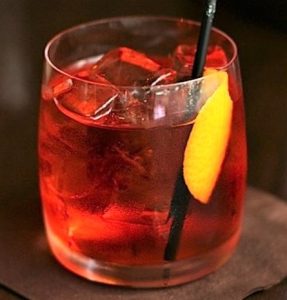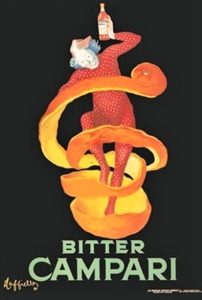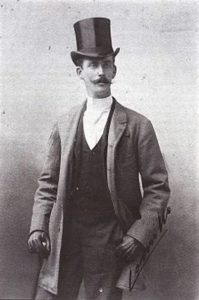 A decade ago, according Bon Appétit magazine, ordering a Negroni was somewhat akin to “a secret handshake, a sign to bartenders that you knew what you liked, and how to order it.” In 2013, GQ magazine wrote that “a Negroni, like black coffee or Texas, is an acquired taste.”
A decade ago, according Bon Appétit magazine, ordering a Negroni was somewhat akin to “a secret handshake, a sign to bartenders that you knew what you liked, and how to order it.” In 2013, GQ magazine wrote that “a Negroni, like black coffee or Texas, is an acquired taste.”
Time warp ahead to 2019, coincidental with the 100th anniversary of its “invention,” and the Negroni has gone from best-kept-secret to “one of the most consumed cocktails in the world, and the most successful mixed drink ever to come out of Italy,” according to the New York Times. The Guardian, a British daily, named it “the” cocktail of 2021 and also invited readers to: “Head to the menswear department of Marks & Spencer and you can even pick up a T-shirt emblazoned with the slogan ‘Negroni’ above a cheery illustration of a tumbler full to the brim with cherry-red liquid.”
Interestingly enough, however, while the Negroni has become so wildly popular of late, it still seems to be very much a case of “hiding in plain sight,” as a great majority of people, or so it seems, have never heard of it… During our recent cruises, for example, my traveling companion and I would pause for a preprandial libation in the ship’s bar/lounge before heading into the main dining room for dinner. She would enjoy her usual Cosmo, while I, of course, would have a Negroni. On several occasions, we were joined by other couples. In one instance, the gentleman took one look at what I was drinking (pictured above) and inquired: “Is that a Manhattan?”
“No,” I said. “It’s a Negroni.”
“What’s a Negroni?” he asked, giving me a look like I’d just arrived from Mars.
A Negroni is composed of equal parts gin (I prefer Bombay Sapphire), sweet vermouth, and Campari (a scarlet-colored Italian bitter that reminds you of the worst-tasting cough medicine you were ever forced to endure as a child). The ingredients are poured into a rocks (old-fashioned) glass filled with ice, stirred, and garnished with a slice of orange or orange peel.
 Yes, I know… This does not sound like the recipe for an iconic cocktail. But, trust me. The gin provides the body, the sweet vermouth the smoothness, and the Campari the bitterness…. And it is the bitterness that makes this drink uniquely special. Though entirely too assertive to sip comfortably by itself, something extraordinary happens when Campari is mixed with the botanicals in gin and the herbs & spices present in sweet vermouth. The drink suddenly becomes incredibly complex, with each sip revealing some exciting new vista. It is truly astonishing how so many different flavors can blend so seamlessly. There is absolutely no question that the Negroni is an acquired taste; but, once acquired, you are hooked… And I am. It has become my favorite cocktail. And I am not alone. Perhaps the late Anthony Bourdain said it best:
Yes, I know… This does not sound like the recipe for an iconic cocktail. But, trust me. The gin provides the body, the sweet vermouth the smoothness, and the Campari the bitterness…. And it is the bitterness that makes this drink uniquely special. Though entirely too assertive to sip comfortably by itself, something extraordinary happens when Campari is mixed with the botanicals in gin and the herbs & spices present in sweet vermouth. The drink suddenly becomes incredibly complex, with each sip revealing some exciting new vista. It is truly astonishing how so many different flavors can blend so seamlessly. There is absolutely no question that the Negroni is an acquired taste; but, once acquired, you are hooked… And I am. It has become my favorite cocktail. And I am not alone. Perhaps the late Anthony Bourdain said it best:
“I think the Negroni is the perfect cocktail because it is three liquors that I don’t particularly like. I don’t like Campari and I don’t like sweet vermouth and I don’t particularly love gin. But you put them together with that little bit of orange rind in a perfect setting… It’s just: It sets you up for dinner, in a way it makes you hungry, sands the edges off the afternoon. In an after dinner, it’s settling. It is both aperitif and digestive. It’s a rare drink that can do that.”
 And it all began in 1919… Recently returned to his native Italy from America, Count Carmillo Negroni stops by the Caffé Casoni in Florence. He asks bartender Fosco Scarselli for an Americano (vermouth, Campari, and soda water). However, on this occasion, he’s looking for something with a bit more punch; so, he requests that the usual soda water be replaced with gin. The bartender obliges, and even switches the traditional lemon garnish to a slice of orange to signify that this is a completely different drink. And the Negroni is born…
And it all began in 1919… Recently returned to his native Italy from America, Count Carmillo Negroni stops by the Caffé Casoni in Florence. He asks bartender Fosco Scarselli for an Americano (vermouth, Campari, and soda water). However, on this occasion, he’s looking for something with a bit more punch; so, he requests that the usual soda water be replaced with gin. The bartender obliges, and even switches the traditional lemon garnish to a slice of orange to signify that this is a completely different drink. And the Negroni is born…
… As origin stories go, of course, this kind of far-fetched glamor sounds just too good to be true. And there are at least several other origin theories circulating about. Far-fetched or not, and glamor notwithstanding, the story most scholars agree upon is the one noted above, tracing the drink back to 1919 Florence and the Caffé Casoni, where the drink was named for its creator, Count Camillo Negroni.
If you’re interested in knowing a bit more about the Negroni, I highly recommend Matt Hranek’s The Negroni: A Love Affair with a Classic Cocktail. This incredible little book, which I have thoroughly enjoyed and reread on several occasions, is an absolute goldmine of intriguing little tidbits about the king of cocktails. The author begins with Essential Components of constructing a Negroni – Bitters, Vermouth, Gin, Garnish, Ice – and moves on to the essential Equipment – Glassware & Barware – you will need. By far, the most intriguing chapter is Recipes. For while the basic Negroni consists of equal parts gin, sweet vermouth, and Campari, the original has spawned a host of variations on the theme.
 The Author’s Negroni, for example, which goes heavier on the bitters and gin and lighter on the vermouth, calls for 1¼ ounces each of Campari & London dry gin and only 3/4 ounce of vermouth. And Mr. Hranek (pictured) cares more about the quality of the glass than he does the ice – his choice is always crystal, preferably something from his Baccarat collection. This sounds like a definite try for me, as I am much more attracted to the bitter aspect the drink rather than its sweetness.
The Author’s Negroni, for example, which goes heavier on the bitters and gin and lighter on the vermouth, calls for 1¼ ounces each of Campari & London dry gin and only 3/4 ounce of vermouth. And Mr. Hranek (pictured) cares more about the quality of the glass than he does the ice – his choice is always crystal, preferably something from his Baccarat collection. This sounds like a definite try for me, as I am much more attracted to the bitter aspect the drink rather than its sweetness.
Another interesting variation is the Il Professore, which originated with Antonio, the bartender at the Grand Hotel Vesuvio in Naples. He adds a splash of coffee liqueur to the classic version and also a few coffee beans as well as the usual orange slice as garnish.
The Boulevardier was invented in Harry’s New York Bar in Paris in the 1920s by the eponymous owner Harry MacElhone. This rendition sticks to the classic recipe with one exception: it substitutes bourbon for gin.
And James Bond fans should be sure to try the Special Agent Negroni. While the martini is always Bond’s drink of choice, in “Risico,” one of the short stories in Ian Fleming’s book For Your Eyes Only, 007 deviates from his usual preference and orders a Negroni. Bond’s version of the cocktail remains the same as the classic recipe, although he always specified Gordon’s gin.
Mr. Hranek’s penultimate chapter, The Snacks, takes a gander at his favorite nibbles that go particularly well with a Negroni. Among the usual suspects – potato chips, green olives, salted nuts, popcorn – he recommends all manner of crunchy, salty items such as firm, salty cheeses, Parma ham, charcuterie, and taralli (ring-shaped Italian breadsticks.
For those of us who enjoy traveling, the author’s final chapter, The Black Book, is more than worth the price of the book itself, as he notes some of his favorite places around the world to enjoy a Negroni. To whet your appetite, here are just a few: Harry’s New York Bar, Paris, France; Thalami, Patmos, Greece; Caffé Gilli, Florence, Italy; Hotel Vilòn, Rome, Italy; Dukes Bar, London, England; St. John Bread and Wine, London, England; I Sodi, New York City; Quince, San Francisco.
In addition to Matt Hranek’s excellent book, for more info about this fabulous cocktail, you also might want to check out Gary Regan’s The Negroni: Drinking to La Dolce Vita, with Recipes & Lore and David T. Smith & Keli Rivers’ Negroni: More Than 30 Classic and Modern Recipes for Italy’s Iconic Cocktail.
Cheers!
Be Safe & Stay Well
TAD

{ 0 comments… add one now }